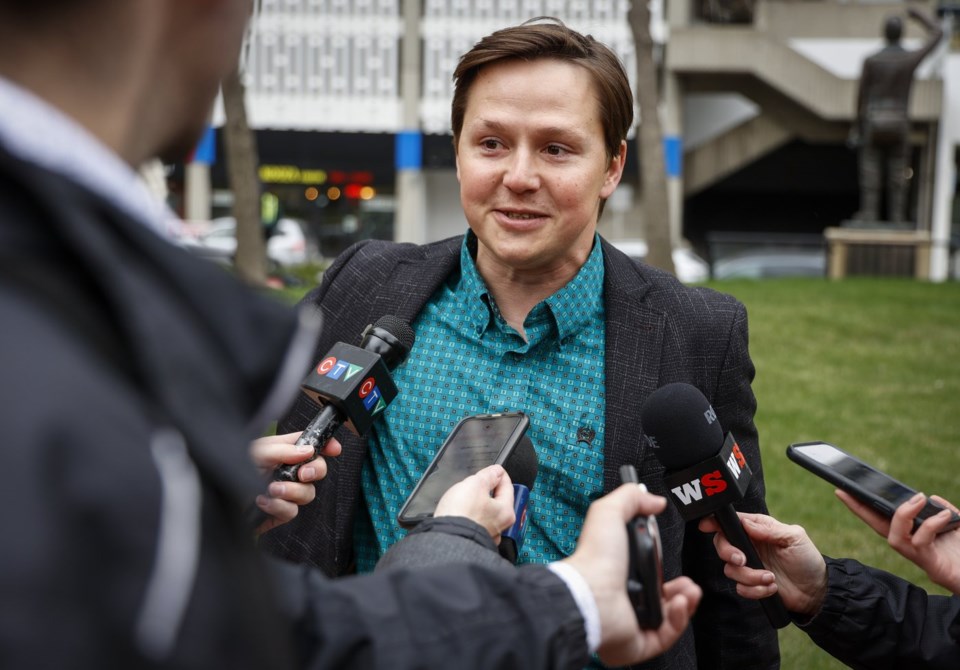EDMONTON — Alberta Transportation Minister Devin Dreeshen, dressed in a “Cash Cow” barbecue apron, announced more changes Monday to further reduce photo radar enforcement.
“This is a historic day for Alberta drivers as we turn up the heat, we fire up the grill, and say goodbye to the photo radar cash cow,” Dreeshen, dressed in a black apron with the words “Cash Cow” crossed out, told reporters at an Edmonton smokehouse.
It was an announcement that Alberta’s top police chief called insulting and one that will put lives at risk.
Dreeshen said that as of April 1 the province is ending photo radar ticketing on all numbered provincial highways.
The province also plans over the coming months to review "cash cows” – photo radar spots that appear to prioritize money-making over safety -- with the goal of shutting down 70 per cent of the current 2,200 sites.
The minister said far too often photo radar penalizes drivers without improving road safety, adding the province doesn’t intend to offer extra cash to make municipalities whole from the lost photo radar revenue.
“The whole point of getting rid of these cash cow locations is to make sure that photo radar is used as a traffic safety tool and not as a revenue generator,” Dreeshen said.
Mark Neufeld, the head of the Calgary Police Service and president of the Alberta Association of Chiefs of Police, criticized the announcement.
Neufeld singled out Dreeshen's barbecue apron and labelled the cash remarks “glib and perhaps inappropriate.”
"Having a provincial cabinet minister speak in this manner is unprofessional and it has the potential to undermine the public's trust and confidence in their police services," Neufeld told a news conference in Calgary later Monday.
"While some people may have thought that was funny, we would encourage the minister to consider those citizens who have been injured or killed on Alberta roadways and their loved ones."
Neufeld said photo radar is working. He said Calgary had 24 traffic deaths in 2023 and 25 so far this year. He said the numbers have dropped considerably with the use of photo radar in the past.
"If we take that away, those treatments out of those locations, I think the inescapable conclusion is we get more collisions, and statistically some will be serious injury and some will be fatal,” he said.
Neufeld said he has made eight requests for a meeting with the minister since July and nothing has happened.
"(The debate) has been framed up as if (photo radar) is just done to generate money,” he said. "It makes it sound as though we're out there putting these things wherever to make money and then using the money for the Christmas party.”
Photo radar will continue to be allowed in school zones, playground zones and construction sites, but beyond these areas, local governments will have to submit their case and show evidence of higher collision rates.
At intersections equipped with cameras, running a red light could still net a driver a ticket, but speeding on green will not — starting in the spring.
The United Conservative Party government has been placing restrictions on photo radar sites in stages. All photo radar sites were removed from ring roads in Calgary and Edmonton last December.
Dreeshen said the province, too, will see less revenue from photo radar.
In 2019, the UCP increased the province’s share of photo radar revenue to 40 per cent from 27. That fiscal year, total revenue generated was $203 million. By last year, total revenue was down to $145 million, Dreeshen said.
Among the top five revenue-generating sites listed by the government in 2023, four are in Edmonton and area, each collecting between $2.1 million and almost $6 million per year.
Kara Westerlund, president of the Rural Municipalities of Alberta, applauded the move. Alberta Municipalities president Tyler Gandam said his organization supports local governments using automated traffic enforcement for safety, but said the new proposed approvals process means more red tape.
NDP Leader Naheed Nenshi said the government is adding red tape, and that municipalities, including Calgary, use photo radar funding to pay for policing.
-- with files from Bill Graveland in Calgary
This report by The Canadian Press was first published Dec. 2, 2024.
Lisa Johnson, The Canadian Press




